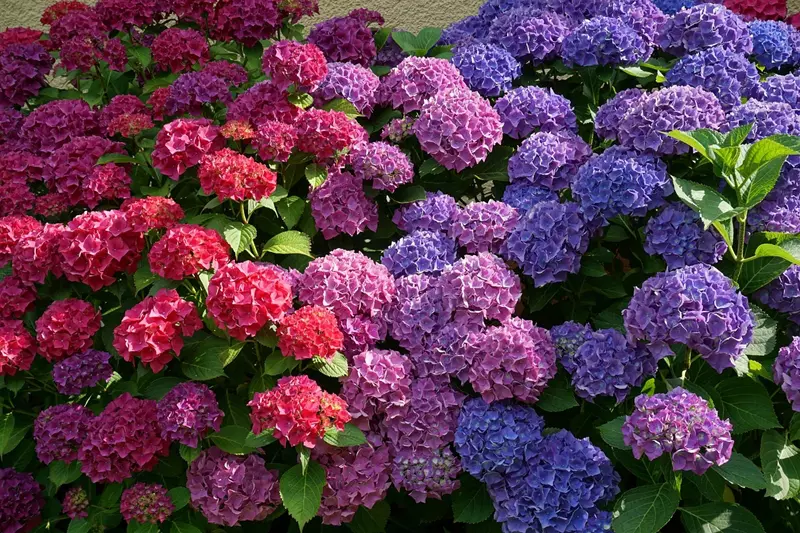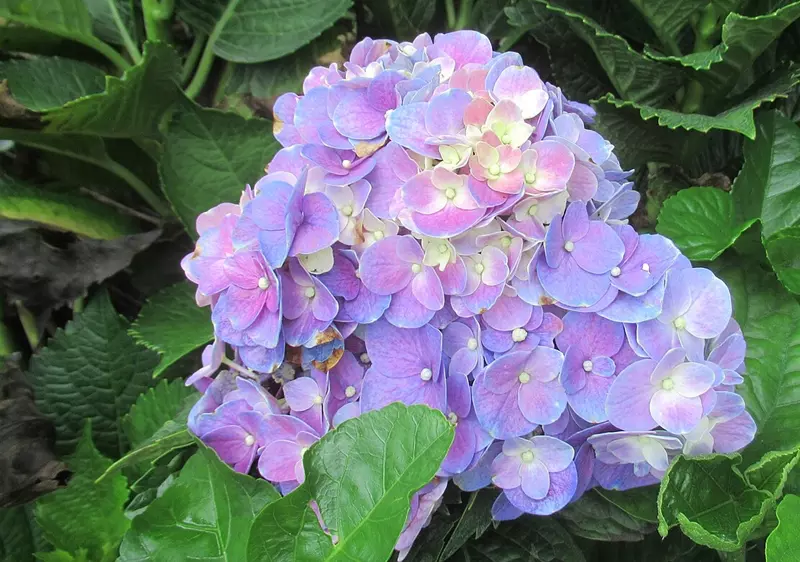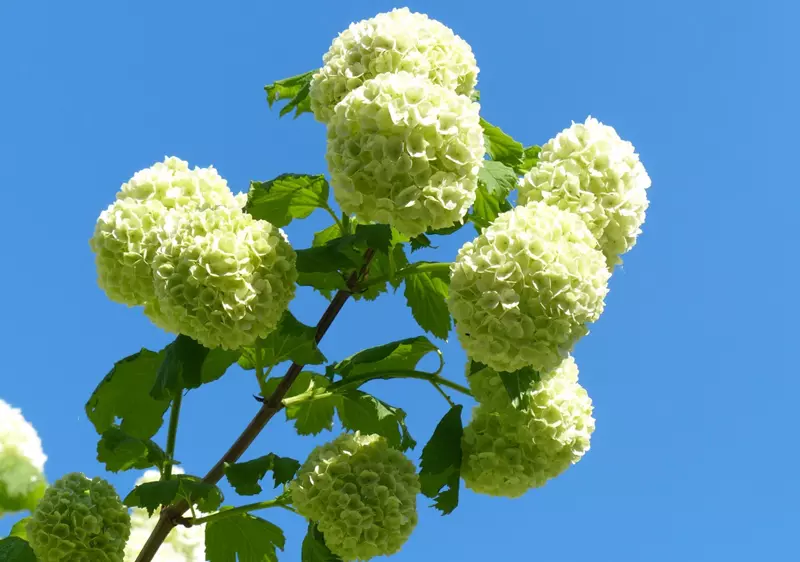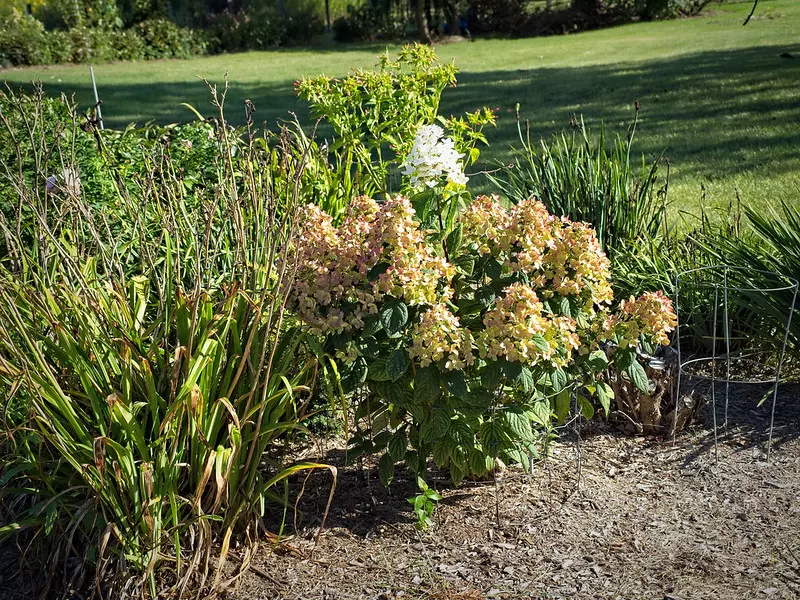Table of Contents
Hydrangeas are cherished for their vibrant and long-lasting blooms. However, premature wilting can be a common issue that diminishes their beauty. Understanding the causes and implementing effective strategies can help maintain the vitality of your hydrangea flowers.
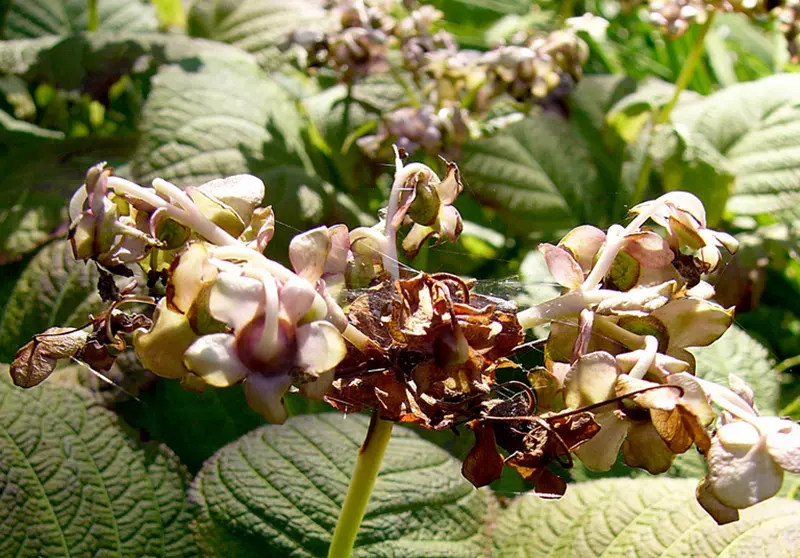 By Philippe Giabbanelli - Own work, CC BY 3.0, Link
By Philippe Giabbanelli - Own work, CC BY 3.0, Link
Causes of Premature Wilting in Hydrangea Flowers
1. Inadequate Watering
Underwatering: Hydrangeas require consistent moisture to thrive. Insufficient watering leads to dehydration, causing leaves and flowers to droop. It's crucial to water deeply, ensuring the soil remains moist but not waterlogged. If your hydrangeas struggle with inconsistent watering, follow these essential watering techniques to maintain optimal soil moisture.
Overwatering: Conversely, excessive watering can suffocate roots, leading to root rot and wilting. Well-draining soil is vital to prevent water accumulation around the roots.
2. Excessive Sun Exposure
Hydrangeas prefer partial shade. Prolonged exposure to intense sunlight, especially during peak hours, can cause heat stress, leading to wilting. If your garden experiences extreme summer temperatures, consider planting hydrangeas in a location with morning sun and afternoon shade.
3. Poor Soil Conditions
Inadequate Drainage: Soil that doesn't drain well can lead to waterlogged conditions, causing root rot and wilting. Incorporating organic matter can improve soil structure and drainage.
Lack of Nutrients: Nutrient-deficient soil can weaken hydrangeas, making them more susceptible to wilting. Regularly amending the soil with compost or balanced fertilisers can support healthy growth.
4. Pest Infestations
Insects such as aphids, spider mites, and scale can damage hydrangeas by feeding on sap, leading to stress and wilting. Regular inspection and appropriate pest control measures are essential to maintain plant health.
5. Diseases
Fungal Infections: Diseases like root rot and leaf spot can cause wilting. Ensuring proper air circulation, avoiding overhead watering, and applying fungicides when necessary can help prevent fungal issues.
Bacterial Wilt: This serious condition leads to rapid wilting and plant death. Affected plants should be removed and destroyed to prevent the spread.
6. Environmental Stress
Factors such as strong winds, extreme temperatures, and transplant shock can cause hydrangeas to wilt. Providing shelter from harsh conditions and acclimating plants properly during transplantation can reduce stress. Additionally, managing hydrangeas in hot climates can help prevent severe environmental stress and dehydration.
Premature wilting in hydrangeas can result from various factors, including improper watering, excessive sun exposure, poor soil conditions, pests, diseases, and environmental stress. Identifying and addressing these issues promptly will help ensure your hydrangeas remain healthy and vibrant.
Early Signs of Wilting in Hydrangeas
1. Drooping Leaves and Stems
One of the most apparent early signs of wilting in hydrangeas is the drooping of leaves and stems. This droopiness indicates that the plant is experiencing water stress, which can result from either insufficient or excessive watering.
- Insufficient Watering: When hydrangeas do not receive adequate moisture, their leaves and stems lose turgor pressure, leading to a limp appearance. Regular watering is essential, especially during hot or dry conditions.
- Excessive Watering: Overwatering can lead to root rot, impairing the plant's ability to absorb water and nutrients, which also results in wilting. Ensuring well-draining soil helps prevent this issue.
2. Leaf Discolouration
Early wilting is often accompanied by changes in leaf colour. Observing these changes can provide insights into the underlying causes:
- Yellowing Leaves: This can indicate overwatering or nutrient deficiencies. It's essential to assess watering practices and consider soil testing to determine nutrient levels.
- Browning or Crispy Edges: Typically a sign of underwatering or exposure to excessive sunlight, leading to leaf scorch. Providing adequate water and ensuring partial shade can mitigate this issue.
3. Reduced Flower Vigour
Wilting can also affect the blooms of hydrangeas. Early signs include:
- Drooping Blooms: Flowers may begin to droop or appear lacklustre, indicating the plant is under stress. Ensuring consistent moisture levels and protecting the plant from extreme heat can help maintain bloom vitality.
- Premature Flower Browning: Blooms turning brown earlier than expected can be a sign of water stress or environmental factors such as excessive sun exposure. Adjusting the plant's location or providing shade during peak sunlight hours can alleviate this problem.
4. Soil Moisture Levels
Monitoring soil moisture is vital, as both drought and waterlogged conditions can lead to wilting.
- Dry Soil: Lack of adequate moisture leads to dehydration, causing wilting. Regular watering and mulching can help maintain consistent soil moisture.
- Waterlogged Soil: Excess moisture can cause root rot, leading to wilting. Ensuring proper drainage and avoiding overwatering are key preventive measures.
5. Environmental Stress Factors
External conditions can contribute to early wilting signs:
- Heat Stress: High temperatures can increase transpiration rates, leading to wilting. Providing shade during peak heat and ensuring adequate watering can mitigate heat stress.
- Transplant Shock: Recently transplanted hydrangeas may exhibit wilting as they adjust to new conditions. Proper planting techniques and post-transplant care are essential to reduce shock.
Identifying the early signs of wilting in hydrangeas-such as drooping leaves and stems, leaf discolouration, reduced flower vigour, and soil moisture irregularities-is essential for prompt intervention. By addressing these indicators and understanding their underlying causes, gardeners can take proactive measures to maintain the health and beauty of their hydrangeas.
Preventative Measures to Stop Hydrangea Flowers from Wilting Prematurely
- Proper Watering Techniques:
- Water deeply at the base of the plant early in the morning to allow absorption before the heat of the day.
- Ensure the soil remains consistently moist but not waterlogged. Check moisture levels by inserting your finger into the soil up to the second knuckle; if it feels dry, it's time to water.
- Optimal Planting Location:
- Choose a site with morning sun and afternoon shade to protect the plant from intense sunlight.
- Consider the specific variety's light requirements, as some hydrangeas tolerate more sun than others.
- Soil Preparation:
- Amend the soil with organic matter to improve drainage and nutrient content.
- Maintain a slightly acidic to neutral pH, as hydrangeas prefer pH levels between 5.5 and 7.0.
- Pest Management:
- Regularly inspect plants for signs of pests. Look for discoloured leaves, sticky residue, or visible insects.
- Use insecticidal soap or neem oil as organic treatment options if infestations are detected.
- Mulching:
- Apply a 2–3 inch layer of organic mulch around the base of the plant to retain soil moisture and regulate temperature.
- Keep mulch a few inches away from the stem to prevent rot.
Additional Tips to Prevent Hydrangea Flowers from Wilting Prematurely
1. Timing of Watering
Watering hydrangeas at the appropriate time of day can significantly impact their health.
- Early Morning Watering: Watering in the early morning allows plants to absorb moisture before the heat of the day, reducing the risk of wilting. This practice also ensures that foliage dries out during the day, minimising fungal growth.
2. Use of Anti-Transpirants
Anti-transpirant sprays can help reduce water loss from hydrangea leaves.
- Application: Applying anti-transpirant products during periods of high heat or drought can minimise transpiration, helping to prevent wilting. Follow the manufacturer's instructions for proper usage.
3. Soil Amendments
Enhancing soil quality can improve water retention and root health.
- Organic Matter: Incorporating compost or well-rotted manure into the soil increases its ability to retain moisture, providing a consistent supply to hydrangea roots.
- pH Monitoring: Regularly testing and adjusting soil pH ensures optimal nutrient availability, promoting robust plant health and reducing susceptibility to wilting.
4. Protective Measures During Extreme Weather
Shielding hydrangeas from harsh environmental conditions can prevent stress-induced wilting.
- Temporary Shade: During heatwaves, using shade cloths or umbrellas can protect hydrangeas from intense sunlight, reducing heat stress.
- Wind Barriers: Erecting windbreaks can shield plants from drying winds that exacerbate moisture loss.
5. Regular Monitoring and Maintenance
Consistent observation and care can preemptively address factors leading to wilting.
- Inspect for Pests and Diseases: Regularly check for signs of infestations or infections, such as discoloured leaves or unusual spots, and take prompt action to treat them.
- Prune Appropriately: Timely pruning of dead or diseased branches enhances air circulation and reduces the risk of wilting.
Implementing these additional tips-timely watering, using anti-transpirants, amending soil, protecting during extreme weather, and regular monitoring-can significantly enhance the resilience of your hydrangeas against premature wilting. Consistent and attentive care will ensure your hydrangeas remain a vibrant highlight in your garden.
Heat and Drought Resistant Hydrangea Varieties
1. Panicle Hydrangea (Hydrangea paniculata)
Panicle hydrangeas are celebrated for their large, cone-shaped flower clusters and exceptional hardiness.
- Heat and Drought Tolerance: These hydrangeas can withstand full sun and are more drought-resistant compared to other species, making them suitable for warmer climates.
- Notable Cultivars:
- 'Limelight': Features lime-green blooms that transition to pink and burgundy in the autumn.
- 'Little Lamb': Known for its compact size and delicate white flowers.
- Care Tips: Plant in well-draining soil with access to full sun to partial shade. Regular watering is essential during establishment, but once mature, they exhibit considerable drought tolerance.
2. Oakleaf Hydrangea (Hydrangea quercifolia)
Distinguished by their lobed leaves resembling oak leaves, Oakleaf hydrangeas offer both aesthetic appeal and resilience.
- Heat and Drought Tolerance: Oakleaf hydrangeas are among the most drought-tolerant hydrangea species, adapting well to dry conditions once established.
- Notable Cultivars:
- 'Snow Queen': Produces large, white flower panicles that age to pink.
- 'Alice': Known for its vigorous growth and sizable blooms.
- Care Tips: Prefer well-drained soil and can thrive in partial to full shade. While they tolerate drought, providing occasional deep watering during prolonged dry spells will promote optimal growth.
3. Smooth Hydrangea (Hydrangea arborescens)
Smooth hydrangeas are appreciated for their adaptability and robust blooms.
- Heat and Drought Tolerance: While they prefer consistent moisture, certain cultivars have demonstrated improved tolerance to heat and occasional drought conditions.
- Notable Cultivars:
- 'Annabelle': Features large, white, globe-shaped flowers and displays resilience in various conditions.
- 'Incrediball': Known for its massive blooms and sturdy stems, offering improved heat tolerance.
- Care Tips: Plant in rich, well-draining soil with access to partial shade. Mulching helps retain soil moisture, and regular watering during dry periods supports healthy growth.
4. Bigleaf Hydrangea (Hydrangea macrophylla)
Bigleaf hydrangeas are known for their large, colourful blooms and are a favourite among gardeners.
- Heat and Drought Tolerance: Generally, Bigleaf hydrangeas require ample moisture and may struggle in dry conditions. However, certain cultivars have been developed to better withstand heat.
- Notable Cultivars:
- 'Endless Summer® BloomStruck®': A hardy option that thrives in Zones 4–9, offering improved heat tolerance.
- 'Let's Dance® Series': Bred for enhanced heat tolerance and vibrant colours.
- Care Tips: Plant in well-draining soil enriched with organic matter. They thrive in partial shade, and consistent watering is crucial, especially during hot, dry periods.
Choosing heat and drought-resistant hydrangea varieties such as Panicle, Oakleaf, Smooth, and select Bigleaf cultivars can significantly enhance garden success in warmer climates. By selecting appropriate species and cultivars and providing them with optimal care, you can enjoy the vibrant beauty of hydrangeas even in challenging conditions. Adaptable and resilient, these varieties prove that hydrangeas can thrive in almost any environment with the right approach.
Seasonal Care for Hydrangea Health
Spring Care
As hydrangeas emerge from dormancy, spring is a critical period for setting the foundation for healthy growth.
- Pruning: Identify your hydrangea species to determine the correct pruning time. For instance, Hydrangea macrophylla (mophead and lacecap) bloom on old wood and should be pruned immediately after flowering, while Hydrangea paniculata and Hydrangea arborescens bloom on new wood and can be pruned in early spring.
- Fertilisation: Apply a balanced, slow-release fertiliser as new growth appears to support robust development. Follow the manufacturer's instructions for application rates.
- Mulching: Refresh mulch around the base of the plants to conserve moisture and regulate soil temperature. A 5–7.5 cm layer of organic mulch is ideal.
- Watering: Ensure consistent soil moisture as plants break dormancy, but avoid waterlogging, which can lead to root rot.
Summer Care
During the peak growing season, hydrangeas require attentive care to maintain their vigour and bloom quality.
- Watering: Hydrangeas need ample water during hot summer months. Water deeply at the base of the plant 2–3 times a week, increasing frequency during prolonged heat or drought conditions.
- Shade Protection: In regions with intense afternoon sun, provide partial shade to prevent leaf scorch and wilting. This can be achieved by planting hydrangeas in locations with morning sun and afternoon shade or by using shade cloths.
- Deadheading: Remove spent blooms to encourage continued flowering and maintain plant appearance. Use clean, sharp shears to make cuts just above a set of healthy leaves.
- Pest Monitoring: Regularly inspect plants for pests such as aphids or spider mites. If detected, treat promptly with appropriate organic or chemical controls.
Autumn Care
As the growing season winds down, autumn is the time to prepare hydrangeas for the upcoming winter months.
- Watering: Continue to water hydrangeas regularly until the ground freezes to ensure they enter dormancy well-hydrated.
- Fertilisation: Cease fertiliser applications by early autumn to prevent promoting new growth that could be damaged by frost.
- Mulching: Add a thicker layer of mulch (7.5–10 cm) to insulate roots against temperature fluctuations and retain soil moisture.
- Pruning: Avoid pruning in autumn, especially for species that bloom on old wood, as this can remove next season's flower buds.
Winter Care
Protecting hydrangeas during winter ensures they survive cold temperatures and emerge healthy in spring. Cold weather can be particularly challenging for certain hydrangea varieties, making proper winter protection essential.
- Protection: In colder climates, shield hydrangeas by constructing a frame around the plant and covering it with burlap or horticultural fleece to protect against harsh winds and frost.
- Mulching: Maintain the autumn-applied mulch to keep roots insulated. In areas with severe winters, consider adding an additional layer of mulch or straw to provide extra warmth.
- Watering: Once the ground is frozen, reduce watering. However, if a mid-winter thaw occurs, provide some moisture if the soil becomes dry, as winter dehydration can weaken the plant.
- Snow Management: Gently brush off heavy snow from branches to prevent breakage, but allow a light snow cover to act as natural insulation, protecting the roots from extreme cold.
Providing tailored seasonal care for your hydrangeas-from strategic pruning and fertilisation to adequate watering and winter protection-will promote their health and enhance their beauty year-round. By understanding and meeting their seasonal needs, you can enjoy abundant blooms and vigorous growth from your hydrangeas. For more winter-specific care strategies, explore our complete guide on protecting hydrangeas from frost and extreme temperatures.
By understanding the factors that contribute to premature wilting and implementing these preventative measures, you can enjoy healthy, vibrant hydrangea blooms throughout the growing season.
About the Author

Richard Seres-Nagy is a passionate gardener with over 20 years of experience in hydrangea care. He founded Hydrangea Library to share expert advice, step-by-step guides, and practical tips for fellow gardening enthusiasts.
Read More
